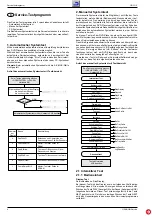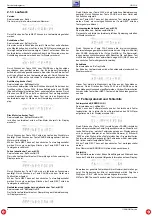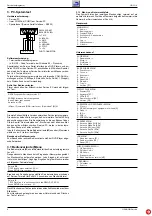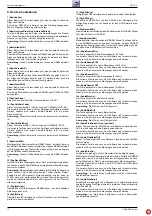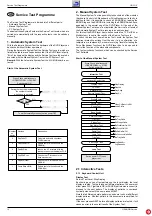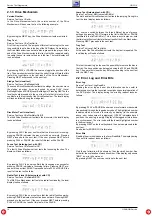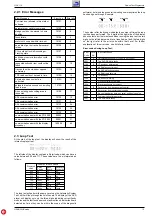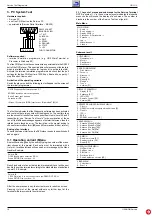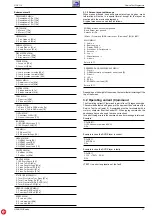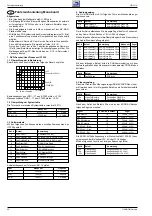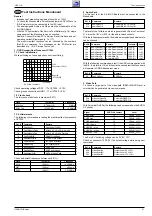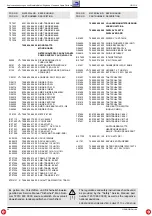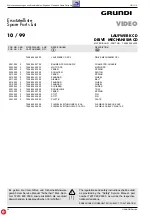
Service Test Programme
GDV 110
18
GRUNDIG Service
4. Service Test Levels
1 (BasicSpAcc)
This is a Basic Diagnostic Nucleus required for correct operation of the
Diagnostic Software.
Checks and initialises RS232 port and outputs a message that the
Diagnostic software has been started.
2 (BasicInterconDram, BasicInterconSdram)
Interconnection test of the address/data lines from and to the proces-
sor. This nucleus can detect stuck at fault and permanent coupling
errors in the address lines and will give an indication which lines are
faulty.
Note: The test BasicInterconDram will only work when a DRAM is
available.
3 (BasicDramWrR)
This is a Basic Diagnostic Nucleus required for correct operation of the
Diagnostic Software.
It performs a pattern test (checkerboard) of only that part of the DRAM
which is required by the Diagnostic Software. It automatically includes
a test of the data lines in which stuck at faults and permanent coupling
errors can be detected.
Note: This test will only work when a DRAM is available.
4 (BasicSdramWrR)
This is a Basic Diagnostic Nucleus required for correct operation of the
Diagnostic Software. It performs a pattern test (checkerboard) of only
that part of the SDRAM which is required by the Diagnostic Software.
It automatically includes a test of the data lines in which stuck at faults
and permanent coupling errors can be detected.
5 (BasicSramWrR)
This is a Basic Diagnostic Nucleus required for correct operation of the
Diagnostic Software. It performs a pattern test (checkerboard) of the
internal SRAM of the STi5505 (IC7200).
6 (PapChksFlash)
Calculate and verify checksum FLASH
7a (PapUclkAclkCdda)
Diagnostic Nucleus PapUclkAclkCdda Switches clock A_CLK from the
microclock to 11.2896MHz (CD_DA).
Correct operation cannot be detected by the Diagnostic Software but
must be checked with external equipment (e.g. a frequency counter).
Note: This nucleus will only work if the external clock is enabled.
7b (PapUclkAclkDvd)
Diagnostic Nucleus PapUclkAclkDvd Switches clock A_CLK from the
microclock to 12.288MHz (DVD).
Correct operation cannot be detected by the Diagnostic Software but
must be checked with external equipment (e.g. a frequency counter).
Note: This nucleus will only work if the external clock is enabled.
9 (PapDramWrR)
Pattern test (checker board) of all locations in the DRAM(s). This
Nucleus can detect stuck at fault and permanent coupling errors in a
DRAM chip and will give an indication if and which DRAM chip is faulty.
The conclusion of this test are only valid under the assumption that the
access to the DRAM is OK.
Note: This test will only work when a DRAM is available.
10 (PapFlashWrAcc)
Reads out the Chip Identification Number. This nucleus tests the write
access by writing a defined sequence of data to the FLASH chip, to be
able to read the FLASH ID.
Note: If the diagnostic software runs from FLASH, this test will hang.
By writing to FLASH memory, the FLASH output-enable-pin is set high
(output disabled) and the code which sits in FLASH memory can not
continue to be executed. However, if the test hangs the output enable
pin is high, and the test apparently was successful.
11 (PapI2cNvram)
Checks the I2C interface with the NVRAM by reading from an arbitrary
address.
12 (PapI2cDisp)
Checks the I2C interface with the slave processor on the display PWB
with the echo command.
13 (PapS2bEcho)
Checks the S2B interface to the Drive Mechanism with an ‘echo’
command.
14 (PapS2bPass)
Switches the RS232 port and the S2B port in pass-through mode. The
only way to exit this nucleus is via a power off of the DVD player.
15 (PapNvramWrR)
Non destructive pattern test (checker board) of all locations in the
NVRAM. This Nucleus can detect stuck at faults and permanent
coupling errors in the NVRAM chip.
16 (CompSdramWrR)
Pattern test (checker board) of all locations in the SDRAM. This
Nucleus can detect stuck at fault and permanent coupling errors in an
SDRAM chip and will give an indicates if the SDRAM chip is faulty. The
conclusion of this test is only valid under the assumption that the
access to the SDRAM is OK.
18a (AudioDeemp0On)
Diagnostic Nucleus AudioDeemp0On switches the audio de-empha-
sis on for 44.1kHz.
Correct operation cannot be detected by the Diagnostic Software but
must be checked externally.
18b (AudioDeemp0Off)
Diagnostic Nucleus AudioDeemp0Off switches the audio de-empha-
sis off for 44.1kHz.
Correct operation cannot be detected by the Diagnostic Software but
must be checked externally.
18c (AudioDeemp1On)
Diagnostic Nucleus AudioDeemp1On switches the audio de-empha-
sis on for 48kHz.
Correct operation cannot be detected by the Diagnostic Software but
must be checked externally.
18d (AudioDeemp1Off)
Diagnostic Nucleus AudioDeemp1Off switches the audio de-empha-
sis off for 48kHz.
Correct operation cannot be detected by the Diagnostic Software but
must be checked externally.
19a (AudioMuteOn)
Diagnostic Nucleus AudioMuteOn switches the audio mute on.
Correct operation cannot be detected by the Diagnostic Software but
must be checked externally.
Note: The audio will be muted by the DAC.
19b (AudioMuteOff)
Diagnostic Nucleus AudioMuteOff switches the audio mute off.
Correct operation cannot be detected by the Diagnostic Software but
must be checked externally.
Note: The audio will be muted by the DAC.
20a (AudioPinkNoiseOn) (only optional)
Diagnostic Nucleus AudioPinkNoiseOn will generate internally on the
STi5505 a pinknoise which will be passed to the DAC were it is
converted to an analogue audio signal.
Correct operation cannot be detected by the Diagnostic Software but
must be checked externally.
20b (AudioPinkNoiseOff)
Diagnostic AudioPinkNoiseOff will switch off the pinknoise generated
with AudioPinkNoiseOn.
Correct operation cannot be detected by the Diagnostic Software but
must be checked externally.
21a (AudioSineOn)
Nucleus AudioSineOn will generate a sine signal of 1 kHz on the
analogue output. The sine signal digital data are stored in the audio
buffer in SDRAM, passed through the audio decoder and without any
further processing to the audio DAC were it is converted to an analogue
audio signal.
Correct operation cannot be detected by the Diagnostic Software but
must be checked externally. The signal can be stopped by pressing the
STOP-key on the DVD player.
Correct operation cannot be detected by the Diagnostic Software but
must be checked externally.
Note: In the playerscript the test AudioSineBurst will be used.

